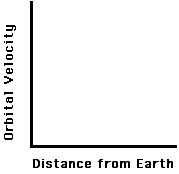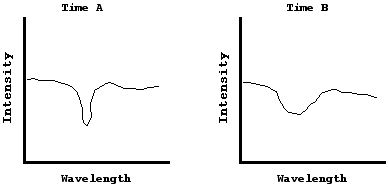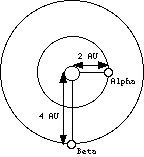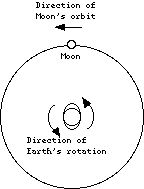DDDD - Gravity and Orbits, Tides, Kepler's Laws
Suppose a new planet X is discovered. This planet is twice as large as the Earth (its radius is twice Earth’s radius) and four times more massive than the Earth. Show your work.
a) (6 pts) State how the gravitational force on X compares to the gravitational force on Earth. Show your work.
b) (6 pts) State how the density of X compares to the density of Earth.
--
Working from the equation defining an orbit, Kepler stated that planets further from the Sun would have longer orbital periods. State two reasons why this is true.
--
Planet X has an orbital velocity four times bigger than planet Y. Using the equation describing an orbit, state how the intensity of sunlight on planet X compares to planet Y. Show your work and state your answer clearly!
--
The equation for the orbital velocity of a planet’s moon is given on the cover page.
a) (6 pts) Suppose Jupiter’s moon, Io, is instead orbiting Saturn, a planet with one-third the mass of Jupiter, at the same distance (r) as it previously orbited about Jupiter. Does Io move (faster/slower/same speed/can’t determine)? Explain.
b) (6 pts) Suppose Io were moved from its present location around Jupiter to a distance twice as far away from Jupiter. Does Io now move (faster/slower/same speed/can’t determine)? Explain.
--
A typical occultation of Jupiter’s moon, Europa, lasts about 3 minutes from the time it begins to pass behind Jupiter until it completely vanishes. Using your knowledge of the equation of orbital velocity (given below), suppose Jupiter were only one-fourth as massive as it is today.
a) (4 pts) The occultation of Europa would take (more/less/same/can’t determine) time in this case.
b) (8 pts) Explain your answer to part (a). You may want to use some equations.
--
This question deals with the tidal effects of the Moon on the Earth.
a) (4 pts) Explain the source both tidal bulges on the Earth (briefly explain each separately).
b) (4 pts) During full moon, would we expect to see higher amplitude (spring) tides or lower amplitude (neap) tides? Explain.
--
The graph below represents the orbital motion of satellites around the Earth, which behave according to the orbital velocity equation.
a) (4 pts) On the graph below, draw in the relation between velocity and distance for this kind of an orbit.
b) (4 pts) Suppose two satellites are orbiting the Earth at distances A and B from the center. B is four times further away from the center of the Earth than A. In a single sentence, state mathematically how the two velocities, v(A) and v(B), are related (e.g. “v(A) is 3 times slower than v(B).”). You may show your work for partial credit, but it is not required.

--
Pluto’s moon, Charon, is very massive and orbits around Pluto every 6 days. It is so close to Pluto that it is nearly impossible to resolve these two objects with a telescopic image at such a large distance. Yet years before the first image of Charon was finally obtained, we could have proven the existence of the Moon, Charon, by observing the spectrum of Pluto and its Doppler shift. Explain how.
--
Below is a side-view of the Earth-Moon system. As the Moon orbits the Earth, a laser emits light with a wavelength of 3000 nanometers toward you, the observer (out of the page). No explanations needed for this problem.
a) (2 pts) The light observed from laser A has a wavelength (longer than/shorter than/same as) 3000 nanometers.
b) (2 pts) The light observed from laser B has a wavelength (longer than/shorter than/same as) 3000 nanometers.

c) (4 pts) If the Moon’s average orbital distance from the Earth doubled, would you expect your answers for (a) or (b) to change? If so, how?
--
Suppose we discover a new planet orbiting another star in a highly elliptical orbit. At two different times, a typical absorption line from the planet’s atmosphere looks like this:

We know that the rotation rate of the planet is constant, and we also know from our own experience in the solar system that the closer a planet is to its central star, the warmer it gets.
a) (2 pts) During which of these two times is the orbital velocity of the planet larger?
b) (6 pts) Explain your answer to part (a)
--
Below is a top view of the Earth-Moon system. Astronauts have placed a laser on the surface of the Moon. This laser at all times points in the direction of you, the observer. When at rest relative to you, the laser’s light has a wavelength of 300 nanometers. No explanations are needed for this problem.
a) (2 pts) When the moon is at location A in its orbit, the light observed by you from the laser has a wavelength (longer than/shorter than/same as) 300 nanometers.
b) (2 pts) When the moon is at location B in its orbit, the light observed by you from the laser has a wavelength (longer than/shorter than/same as) 300 nanometers.

c) (4 pts) If the Moon orbited the Earth at twice the current distance, would the wavelengths you observed in parts a and b (not necessarily 300 nanometers in either case) change? If so, how?
--
The equation for orbital velocity is given on the cover page.
The moon Io orbits Jupiter once every 10 hours. Suppose Jupiter were twice as massive and that Io orbited four times further away from the center of Jupiter.
a) (2 pts) How would the period of the orbit change (shorter, longer, same, can’t determine)?
b) (6 pts) Explain two reasons why the period depends upon r.
--
The orbital period of Jupiter’s Moon, Io, is 10 hours. Suppose Jupiter were twice as massive and twice as large as it is today.
a) (2 pts) The orbital period of Io would be (longer, shorter, the same).
b) (6 pts) Explain your answer to part (a).
--
Tidal interactions can be used to explain several phenomena in planetary astronomy, including things outside our own solar system.
a) (6 pts) Tidal forces are currently pulling Neptune’s moon Triton inward, and this fact is related to Triton’s origin. Explain how we know that Neptune’s moon Triton is a captured satellite rather than one that formed as part of the Neptune system originally.
b) (8 pts) When large planets form in other solar systems, some models suggest that they spiral inward toward their parent star due to a kind of frictional force with the dusty disk they formed from. Explain two reasons (one of them having to do with tidal forces) why in these models the planets stop spiraling inward and are left at very close distances to their parent stars (which would explain dozens of the systems seen so far that look like this).
--
To an astronaut on the surface of the Moon, it appears that the Earth remains stationary in the sky, although during the course of a month, it appears to grow slightly larger and then slightly smaller in angular size. Explain what causes this (a diagram may help but is not required).
--
Suppose you’re Charlton Heston, and you’ve returned to the Earth after a space journey of thousands of years. Upon your return, you notice that the Moon is about twice as far away from the Earth as it was when you left. Since you weigh about the same on Earth as you did when you left, you know that the mass of the Earth hasn’t changed.
a) (5 pts) When you left, the orbital period of the Moon was about 30 days. Has it increased, decreased or stayed the same since that time? Explain your answer.
b) (3 pts) In order to impress the local population, you predict the day and time of a solar eclipse. Will the eclipse be annular or total? Explain your answer.
--
Below is a top view of a newly discovered solar system. This system has a central star exactly the same as our Sun. The two planets in this system are Alpha (2 AU from the star) and Beta (4 AU from the star). We view this system edge-on from Earth, so both Alpha and Beta appear to have Doppler shifts due to their bulk velocity as they orbit the star.
a) (6 pts) When both planets are moving toward us, which one will appear to be blueshifted more (Alpha, Beta, neither one)? If you need to refer to the equation of orbital velocity, it is given elsewhere in the exam. Explain.

b) (6 pts) The inverse square law tells us that that the intensity of light received by a planet is proportional to 1/r2, where r is the distance from the planet to the star it orbits around. State how much light planet Alpha receives compared to planet Beta (e.g. “Alpha receives 15 times more light than Beta”). No explanation necessary here, but show work for possible partial credit if wrong.
--
Saturn’s moon, Mimas, which causes the Cassini Division in Saturn’s rings due to resonance effects, has an orbital period around Saturn of approximately 20 hours.
If Mimas were struck by an asteroid and moved closer to Saturn (but not so close as to be within the Roche limit)...
a) (3 pts) The orbital period of Mimas would (increase, decrease, stay the same). No explanation needed, though you may show any work for partial credit.
b) (5 pts) Would the location of the Cassini Division move (closer to Saturn, further from Saturn, remained unchanged)? Explain your answer.
--
Kepler's major contribution to solar system astronomy was his discovery of some basic laws governing planetary motion. One of these was that planets "sweep out equal areas in equal times".
a) (7 pts) Explain why this statement is essentially the equivalent of the relationship between orbital velocity and orbital distance deduced years later when the equation of orbital velocity was first proposed and used.
b) (7 pts) One problem with the geocentric theory is that it was in a sense irrefutable. Every time contradictory evidence was found, the theory was changed to meet the new facts. What is the major weakness of this kind of irrefutable theory when used as a basis for a system of knowledge (this weakness is why scientists give less credibility to changing theories, as they drift toward "irrefutable" status)? Explain.
--
Our searches for extrasolar planets have found many planets with masses at least equal to the mass of Jupiter orbiting very close to their parent stars.
a) (4 pts) Explain why we are biased in our searches in favor of both planets with large masses and in favor of planets with relatively short periods.
b) (4 pts) The masses we determine for the companion planets are minimums. Explain why we aren't able to determine the true mass of a companion planet most of the time and why the estimated mass is always less than the true mass.
--
Our calculations and measurements of the dynamics of the Earth-Moon system tell us that the Moon is very slowly receding from the Earth. Explain what tidal effect is causing the Moon to get further away from the Earth (diagram will definitely help here).
--
The Earth is the only terrestrial planet with a major satellite, and some suggest that we are pretty lucky to have one.
a) (7 pts) Our cycle of tides (2 high tides, 2 low tides) lasts somewhat longer than 24 hours. Explain why.
b) (7 pts) Suppose the Earth had no moon, would we still experience tides? Explain.
--
Currently, if an area experiences a high tide at 10:00am on a given day, the high tide will occur at about 10:40am on the following day. Suppose the Moon were to continue orbiting counterclockwise as viewed from above but the Earth's direction of rotation so that Earth rotates clockwise. As a result of this new rotation direction, would you expect the high tide on the following day to be
- about 10:40am?
- somewhere between 10:00am and 10:40am?
- about 10:00am?
- earlier than 10:00am?
Explain your answer.
--
Our tidal patterns on Earth depend to a large extent upon the current phase of the Moon. During a solar eclipse, would you expect to experience normal tide amplitudes, higher than normal amplitudes or lower than normal amplitudes? Explain your answer.
--
Briefly explain the two sources of Io's intense geological activity.
--
Explain the source of Mercury's internal heat, which we think is related to tides.
--
Use a diagram to help explain how tidal effects are causing the Moon to slowly recede from the Earth over time.
--
If Mercury had oceans of liquid water on its surface (and somehow that water managed to stay in liquid form on the surface for a long period of time)...
a) Would Mercury ever experience tides?
b) Use a diagram to help explain your answer in part (a).
--
If, for some bizarre reason, Mercury actually had oceans of liquid on its surface, it would experience tides just like the Earth! In fact, Mercury would experience higher than usual tides at times as well as lower than usual tides (the amplitudes of the tides would vary), just like the Earth’s so-called “spring” and “neap” tides, but for different reasons.
a) Why would the amplitude of Mercury’s tides differ over the course of a Mercurian year (88 days long)?
b) Use a diagram to help explain your answer in part (a).
--
If the Earth no longer had a moon, would we still have high tides and low tides twice per day? Explain.
--
Recently, we discovered what may be a small patch of ice on the surface of the Moon. Suppose someday in the distant future, the Moon is covered with water, though it would remain tidally locked with the Earth. Think carefully before answering this one about what objects are responsible for tides on the Earth.
a) (3 pts) Would you expect to see variations in water levels (high and low tides) on the Moon? If so, during what phases would tide variations be the strongest?
b) (3 pts) Explain your answer to part (a).
--
As the Sun sets in the Western sky, you notice that the Moon is almost directly overhead in its “first quarter” phase (half of the side facing Earth is lit up). Would you expect tide amplitudes to be (higher than normal, just about normal, lower than normal) on this day? Explain your answer with the help of a simple diagram.
--
For the purposes of this problem, assume that the tidal bulges of Earth’s oceans always point toward the Moon as shown below. We know that high tides occur on Earth “about every 12 hours”. However, between high tide times, the Moon moves a little bit in its orbit in the direction shown. Are high tides on Earth separated by a time of (a little more than 12 hours, almost exactly 12 hours, or a little less than 12 hours)? Explain your answer!

--
As the Sun sets in the Western sky, you notice that the Moon is just now rising up over the Eastern horizon. Would you expect tide amplitudes to be (higher than normal, just about normal, lower than normal) on this day? Explain your answer with the help of a simple diagram.
--
Our tidal patterns on Earth depend to a large extent on the current phase of the Moon. No explanations are necessary for this problem.
a) (2 pts) During a lunar eclipse, we experience (normal, higher than normal, lower than normal) tide amplitudes.
b) (2 pts) During New Moon, we experience (normal, higher than normal, lower than normal) tide amplitudes.
c) (2 pts) During New Moon, how often would a given point on the Earth experience high tides?
d) (2 pts) Would your answer to (c) change if the Earth had no Moon? (yes/no)
--
Currently, the time that passes for one part of the Earth between maximum high tide level is a little longer than 12 hours. This has to do with the fact that the Earth rotates and the tidal bulge on the Earth always points pretty close to the Moon (it is always aligned with the Moon’s position). Suppose the Moon were orbiting the Earth in the opposite direction. Would the time difference between high tides be a little longer than 12 hours, exactly 12 hours or a little shorter than 12 hours? Explain.
--
Because of the Moon's orbit and rotation, which keeps it tidally locked with Earth, there are some interesting timing effects.
a) (7 pts) Explain why the time from one high tide to the next is slightly longer than the 12 hours you might expect in an ideal case where the Earth's tidal bulges point to a stationary Moon.
b) (7 pts) How often does a given location on the Moon experience sunrise? Explain your answer with the help of a simple diagram.
--
As a result of the Moon's pull on Earth's two tidal bulges, the rotation of the Earth is slowing down while the orbital distance between the Moon and Earth is slowly increasing. Explain the causes of these two effects.
--
Currently, if an area experiences a high tide at 8:00am on a given day, the high tide will occur at about 8:40am on the following day. Suppose the Earth were to continue rotating counterclockwise as viewed from above but the Moon's orbital direction were reversed so that it orbits the Earth clockwise. As a result of this new orbital direction, would you expect the high tide on the following day to be
- about 8:40am?
- somewhere between 8:00am and 8:40am?
- about 8:00am?
- earlier than 8:00am?
Explain your answer.
--
Suppose the Earth were to continue rotating counterclockwise as viewed from above but the Moon's orbital direction were reversed so that it orbits the Earth clockwise. As a result of this new orbital direction, would the Moon's orbit tend to gain energy (and move outward away from the Earth) or lose energy (and move inward toward the Earth) over time? Justify your answer (a diagram may help).





